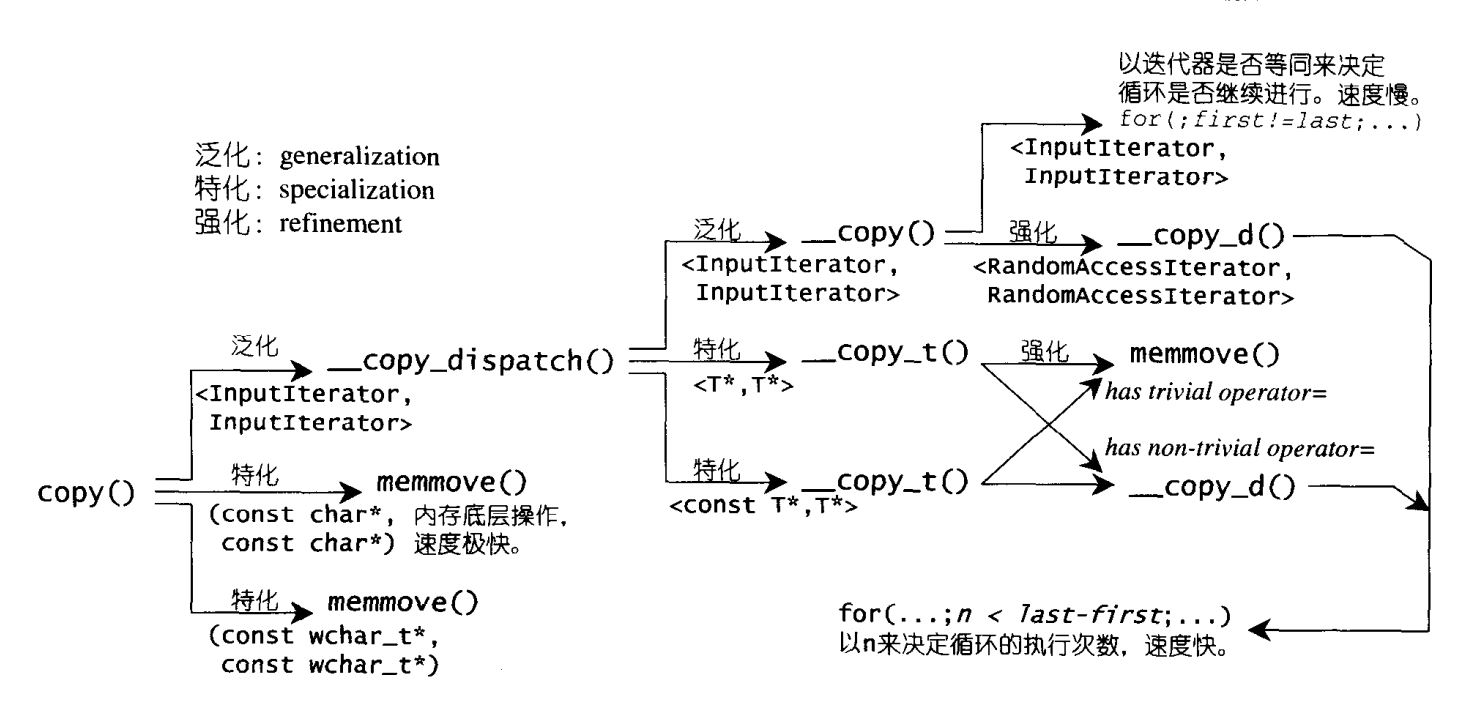第6章:算法
算法概观
算法,问题之解法也。以有限的步骤,解决逻辑或数学上的问题,这一专门科目称为算法。STL 正是将极具复用价值的算法进行封装,包含sort,find,copy等函数。
STL算法总览
所有的STL算法都作用在迭代器 [first,last) 所标出来的区间上。根据是否改变操作对象的值,可以分为 质变算法(mutating algorithms)和 非质变算法 (nomutating algorithms)。
质变算法,是指运算过程中会更改区间内元素的内容的算法。
- 拷贝(copy),互换(swap),替换(replace),填写(fill),删除(remove),排列组合(permutation),分割(partition),随机重排(random shuffling),排序(sort)等。
非质变算法,是指运算过程中不会更改区间内元素的内容的算法。
- 查找(find),匹配(search),计数(count),巡访(for_each),比较(equal,mismatch),寻找极值(max,min)等。但是在for_each算法上应用一个会改变元素内容的仿函数,所在元素必然会改变:
#include<iostream>
#include<vector>
#include<algorithm>
using namespace std;
template <class T>
struct myplus{
void operator()(T& x) const
{x =x+5;}
};
template <class T>
struct display{
void operator()(T& x) const
{cout<<x<<" ";}
};
int main()
{
int ia[] = {1,2,3,4,5};
vector<int> iv(ia,ia+sizeof(ia)/sizeof(int));
for_each(iv.begin(),iv.end(),myplus<int>());
for_each(iv.begin(),iv.end(),display<int>()); //6 7 8 9 10
return 0;
}
算法的泛化过程
如何将算法独立于其所处理的数据结构之外,不受数据结构的约束?关键在于,要把操作对象的型别加以抽象化,把操作对象的标示法和区间目标的移动行为抽象化,整个算法也就在一个抽象层面上工作了。整个过程称为算法的泛型化(generalized),简称泛化。
以简单的循序查找为例,编写find()函数,在array中寻找特定值。面对整数array,写出如下程序:
int* find(int* arrayHead, int arraySize, int value)
{
int i=0;
for (; i<arraySize; ++i)
{
if (arrayHead[i] == value)
{
break;
}
}
return &(arrayHead[i]);
}
上述find()函数写法暴露了太多的实现细节(例如arraySize),为了让find()适用于所有类型的容器,其操作应该更抽象化些。让find()接受两个指针作为参数,标示一个操作区间:
int* find(int* begin, int*end, int value)
{
while(begin !=end && *begin != value)
++begin;
return begin;
}
由于find()函数之内并无任何操作是针对特定整数array而发的,所以我们可以把它改成一个template:
template<typename T>
T* find(T* begin, T* end, const T& value)
{
// 注意,以下用到了operator!=, operator*, operator++
while (begin != end && *begin != value)
++begin;
// 注意,以下返回操作用会引发copy行为
return begin;
}
在上述代码中,传入的指针必须支持以下四种操作行为:
- inequality 判断不相等
- dereferencelm 提领
- prefix increment 前置式递增
- copy 复制
上述操作符可以被重载(overload),find()函数就可以从原生(native)指针的思想框框中跳脱出来。我们可以设计一个class,拥有原生指针的行为,这就是迭代器(iterator):
template<typename Iterator, typename T>
Iterator find(Iterator begin, Iterator end, const T& value)
{
while(begin != end && *begin != value)
++begin;
return begin;
}
至此,便是完全泛型化的find()函数。
数值算法
C++ STL 的数值算法(Numeric algorithms)是一组对容器元素进行数值计算的模板函数,包括容器元素求和 accumulate 、两序列元素的内积 inner_product 、容器元素的一系列部分元素和 partial_sum 、容器每对相邻元素的差adjacent_difference。其头文件为<numeric>,测试实例如下:
// file: 6numeric.cpp
#include <numeric>
#include <vector>
#include <functional> // minus<int>()
#include <iostream> // ostream_iterator
#include <iterator>
using namespace std;
int main() {
int ia[5] = {1, 2, 3, 4, 5};
vector<int> iv(ia, ia + 5);
// 0+1+2+3...
cout << accumulate(iv.begin(), iv.end(), 0) << endl;
//0是初值,T accumulate(InputIterator first, InputIterator last, T init)
// 0-1-2-3
cout << accumulate(iv.begin(), iv.end(), 0, minus<int>()) << endl;
// 10 + 1*1 + 2*2 + ...
cout << inner_product(iv.begin(), iv.end(), iv.begin(), 10) << endl;
// 10 - 1+1 - 2+2 - ...
cout << inner_product(iv.begin(), iv.end(), iv.begin(), 10,
minus<int>(), plus<int>()) << endl;
// 将迭代器绑定到cout,作为输出用
ostream_iterator<int> oite(cout, " ");
// 1 3 6 10 15 累计和
partial_sum(iv.begin(), iv.end(), oite);
cout << endl;
// 1 -1 -4 -8 -13 累计差
partial_sum(iv.begin(), iv.end(), oite, minus<int>());
cout << endl;
// 1 1 1 1 1 new #n = #n - #n-1
adjacent_difference(iv.begin(), iv.end(), oite);
cout << endl;
// 1 3 5 7 9 new #n = op(#n, #n-1)
adjacent_difference(iv.begin(), iv.end(), oite, plus<int>());
cout << endl;
// mingw c++ 中stl没有power实现
// cout << power(10, 3) << endl;
// cout << power(10, 3, plus<int>()) << endl;
int n = 3;
iota(iv.begin(), iv.end(), n); // 填入n, n+1, n+2
for (int i = 0; i < iv.size(); ++i)
cout << iv[i] << ' ';
return 0;
}
运行结果:
[root@192 6_STL_algorithms]# ./6_3_1_numeric
15
-15
65
-20
1 3 6 10 15
1 -1 -4 -8 -13
1 1 1 1 1
1 3 5 7 9
3 4 5 6 7 [
基本算法
equal作用:判断[first,last)区间两个元素是否相同,第二个迭代器多出来的元素不予考虑。
template <class _InputIter1, class _InputIter2>//版本1
inline bool equal(_InputIter1 __first1, _InputIter1 __last1,
_InputIter2 __first2) {
for ( ; __first1 != __last1; ++__first1, ++__first2)//遍历区间[first,last)元素
if (*__first1 != *__first2)//只有有一个不相等返回false
return false;
return true;
}
template <class _InputIter1, class _InputIter2, class _BinaryPredicate>//版本2
inline bool equal(_InputIter1 __first1, _InputIter1 __last1,
_InputIter2 __first2, _BinaryPredicate __binary_pred) {
for ( ; __first1 != __last1; ++__first1, ++__first2)
if (!__binary_pred(*__first1, *__first2))//两个元素执行二元操作符
return false;
return true;
}
fill作用:将指定区间元素改为新值。
template <class _ForwardIter, class _Tp>
void fill(_ForwardIter __first, _ForwardIter __last, const _Tp& __value) {
for ( ; __first != __last; ++__first)//遍历整个区间
*__first = __value;//指定新值
}
fill_n作用:将指定区间前n个元素改为新值。
template <class _OutputIter, class _Size, class _Tp>
_OutputIter fill_n(_OutputIter __first, _Size __n, const _Tp& __value) {
for ( ; __n > 0; --__n, ++__first)
*__first = __value;
return __first;
}
iter_swap作用:将两个迭代器所指对象调换。
template <class _ForwardIter1, class _ForwardIter2, class _Tp>
inline void __iter_swap(_ForwardIter1 __a, _ForwardIter2 __b, _Tp*) {
_Tp __tmp = *__a;
*__a = *__b;
*__b = __tmp;
}
template <class _ForwardIter1, class _ForwardIter2>
inline void iter_swap(_ForwardIter1 __a, _ForwardIter2 __b) {
__iter_swap(__a, __b, __VALUE_TYPE(__a));
}
lexicographical_compare作用:以字典排序方式对两个序列进行比较,第一个元素小于第二个元素返回true。
mismatch作用:用来比较两个序列,指出两者之间第一个不匹配点。
copy函数: 由于copy进行的是复制操作,而复制操作不外乎用assignment operator或copy constructor(copy算法用的是前者),但是某些元素型别拥有的是trivial assginment operator,因此,如果能够使用内存直接复制行为(例如C标准函数memmove或memcpy),便能够节省大量时间。为此,SGI STL的copy算法用尽各种办法,包括函数重载、型别特性、偏特化等编程技巧,无所不用其极地加强效率。如下图所示:

注意:
copy只是将输出区间内的元素赋予新值,不会产生新的元素,所以copy不能直接用来将元素插入空容器中.
copy的输出区间的起点如果位于输入区间内,可能会使copy算法出错。
